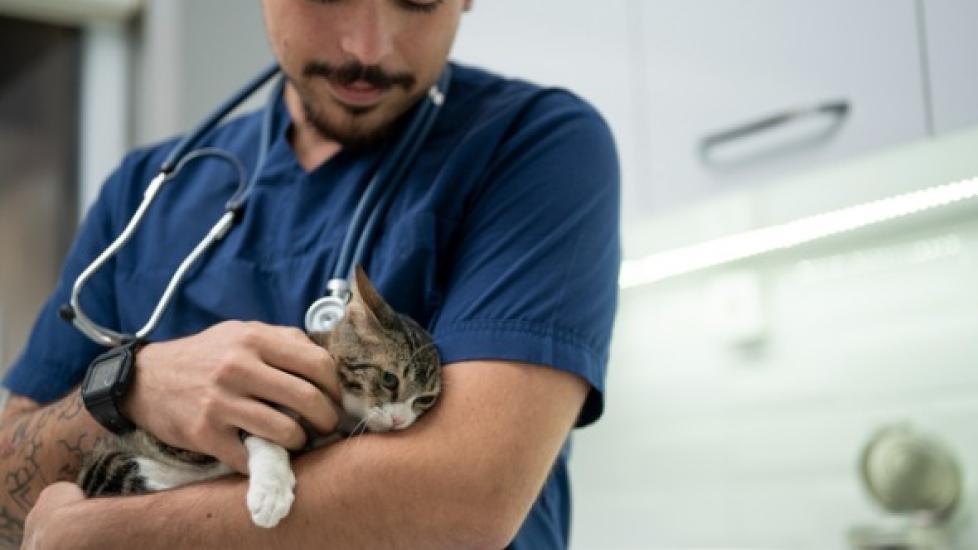Vestibular Disease in Cats
What Is Vestibular Disease in Cats?
If you’ve ever experienced dizziness or vertigo, then you’ve experienced the vestibular system when it stops working. The vestibular system controls balance and coordination in both humans and other mammals, including cats. It is located in the inner ear and the brain.
When this system is disrupted, the cat's world view and axis is shifted. It becomes challenging to tell which way is down and which way is up. Consequently, cats suffering from vestibular disease may develop a head tilt, fall over, and have trouble walking. Oftentimes this unsettling feeling of loss of balance leads to nausea and vomiting. Vestibular disease in cats usually comes on very suddenly and is more common in Siamese and Burmese breeds. While it’s most commonly seen in senior cats, felines of any age can be affected.
Symptoms of Vestibular Disease in Cats
- Rapid, jerking eye movements (nystagmus)
- Head tilt
- Circling or falling to one side
- Loss of balance (ataxia)
- Vomiting, nausea, decreased appetite
- Facial drooping, “Horner’s Syndrome”
Causes of Vestibular Disease in Cats
Anything that can damage the vestibular apparatus can lead to vestibular disease. Oftentimes, no underlying cause is found, and it is classified as Idiopathic Vestibular Syndrome. “Idiopathic” means the cause is unknown. Vestibular disease may be caused by:
- Inner or middle ear infection
- Unknown cause (“Idiopathic”)
- Bacterial or inflammatory conditions of the brain, like Feline Infectious Peritonitis (FIP) or intracranial empyema (brain abscess)
- Drug reaction
- Cancerous tumors, cysts, or polyps that grow in regions near the inner ear or brain. These are more common in senior cats. Sometimes these tumors are brain tumors that are very serious, and other times they may be benign polyps in the ear that are less serious.
- Thiamine deficiency
How Veterinarians Diagnose Vestibular Disease in Cats
Vestibular disease is most often diagnosed via a physical exam by your veterinarian. There is no one test that will confirm this disease. Instead, the vet will want to check your cat thoroughly and screen for signs of problems that could cause vestibular disease, like an ear infection or a growth that may be disrupting the vestibular apparatus.
Blood work may be recommended to screen for signs of an underlying systemic infection in your cat’s body. The vet may recommend x-rays of your cat’s skull to see if there are any obvious masses. Ear cultures may be helpful if signs of an ear infection are present. Occasionally, referral to a veterinary neurologist may be in order if advanced diagnostics, like MRI or CT, are recommended.
Treatment of Vestibular Disease in Cats
If there are underlying causes (like an inner ear infection or polyp) that are discovered on exam, then treatment involves addressing the underlying cause. Antibiotics may be useful if there is an infection present, or anti-inflammatory drugs if obvious inflammation is precipitating the disease. Sometimes surgery is needed to remove troublesome polyps (or growths) if your cat is otherwise healthy and a good candidate for anesthesia.
In most vestibular patients, no underlying cause is ever found. Fortunately, this disease often improves on its own over a couple days, with the majority of signs resolving over a few weeks. Very rarely will cats have a subtle head tilt or facial drooping remaining long after having a diagnosis of vestibular disease.
During the recovery period, it is important to provide supportive care. Helping your cat with the food and water bowl so that it can eat and drink—and even helping it in and out of the litter box—may be necessary. Anti-nausea medications, like Cerenia, are often beneficial initially while your cat is going through the worst of its dizziness and vertigo sensations. Sometimes hospitalization is required for a few days until the worst of the vestibular disease signs pass.
Recovery and Management of Vestibular Disease in Cats
The worst of the disease signs usually last 24 to 48 hours. Most cats with vestibular disease will be mostly normal after a period of 2 to 3 weeks. The overall prognosis for this disease is good with most patients making a full recovery, and not having any repeat episodes in the future.
Featured Image: iStock.com/ilkermetinkursova
References
- FitzMaurice, M. Cornell Feline Health Center. Vestibular Syndrome. (2016)
- Grapes NJ, Taylor-Brown FE, Volk HA, De Decker S. Clinical reasoning in feline vestibular syndrome: which presenting features are the most important? J Feline Med Surg. 2021 Aug;23(8):669-678.
